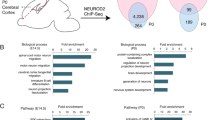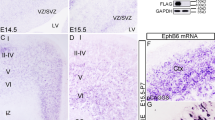Abstract
Molecular genetic studies implicate fibroblast growth factor 8 (FGF8), and the transcription factor Emx2, in development of the neocortical area map. Both are proposed to specify area position along the anterior-to-posterior axis of the cortical primordium. Whether FGF8 and Emx2 act independently or coordinately, or whether one controls the other, has not been determined. Here we report that Emx2, by regulating FGF8, has an indirect but vital role in area-map development. Using electroporation-mediated gene transfer in living mouse embryos, we found that overexpressing Emx2 altered the area map, but only when ectopic Emx2 overlapped the FGF8 source. Furthermore, we found that FGF8 levels were decreased by excess Emx2, and increased in mice lacking Emx2. Finally, cortical domain shifts that characterize Emx2 mutants were rescued by sequestering excess FGF8 with a truncated FGF receptor construct. These findings begin to clarify the signaling network that patterns the neocortical area map.
This is a preview of subscription content, access via your institution
Access options
Subscribe to this journal
Receive 12 print issues and online access
$209.00 per year
only $17.42 per issue
Buy this article
- Purchase on Springer Link
- Instant access to full article PDF
Prices may be subject to local taxes which are calculated during checkout







Similar content being viewed by others
Accession codes
References
Nauta, W.J.H. & Feirtag, M. Fundamental Neuroanatomy (W.H. Freeman, New York, 1986).
Rakic, P. Specification of cerebral cortical areas. Science 241, 170–176 (1988).
Barbe, M.F. & Levitt, P. The early commitment of fetal neurons to the limbic cortex. J. Neurosci. 11, 519–533 (1991).
Miyashita-Lin, E.M., Hevner, R., Wassarman, K.M., Martinez, S. & Rubenstein, J.L.R. Early neocortical regionalization in the absence of thalamic innervation. Science 285, 906–909 (1999).
Nakagawa, Y., Johnson, J.E. & O'Leary, D.D. Graded and areal expression patterns of regulatory genes and cadherins in embryonic neocortex independent of thalamocortical input. J. Neurosci. 19, 10877–10885 (1999).
Cohen-Tannoudji, M., Babinet, C. & Wassef, M. Early determination of a mouse somatosensory cortex marker. Nature 368, 460–463 (1994).
Arimatsu, Y., Ishida, M., Takiguchi-Hayashi, K. & Uratani, Y. Cerebral cortical specification by early potential restriction of progenitor cells and later phenotype control of postmitotic neurons. Development 126, 629–638 (1999).
O'Leary, D.D. & Nakagawa, Y. Patterning centers, regulatory genes and extrinsic mechanisms controlling arealization of the neocortex. Curr. Opin. Neurobiol. 12, 14–25 (2002).
Garel, S., Huffman, K.J. & Rubenstein, J.L.R. Molecular regionalization of the neocortex is disrupted in Fgf8 hypomorphic mutants. Development 130, 1903–1914 (2003).
Monuki, E.S. & Walsh, C.A. Mechanisms of cerebral cortical patterning in mice and humans. Nat. Neurosci. 4, 1199–1206 (2001).
Ragsdale, C.W. & Grove, E.A. Patterning the mammalian cerebral cortex. Curr. Opin. Neurobiol. 11, 50–58 (2001).
Rubenstein, J.L.R. et al. Genetic control of cortical regionalization and connectivity. Cereb. Cortex 9, 524–532 (1999).
Wolpert, L. One hundred years of positional information. Trends Genet. 12, 359–364 (1996).
Bachler, M. & Neubuser, A. Expression of members of the Fgf family and their receptors during midfacial development. Mech. Dev. 100, 313–316 (2001).
Furuta, Y., Piston, D.W. & Hogan, B.L. Bone morphogenetic proteins (BMPs) as regulators of dorsal forebrain development. Development 124, 2203–2212 (1997).
Crossley, P.H. & Martin, G.R. The mouse Fgf8 gene encodes a family of polypeptides and is expressed in regions that direct outgrowth and patterning in the developing embryo. Development 121, 439–451 (1995).
Shimamura, K. & Rubenstein, J.L.R. Inductive interactions direct early regionalization of the mouse forebrain. Development 124, 2709–2718 (1997).
Eagleson, K.L. & Levitt, P. Complex signaling responsible for molecular regionalization of the cerebral cortex. Cereb. Cortex 9, 562–568 (1999).
Grove, E.A., Tole, S., Limon, J., Yip, L. & Ragsdale, C.W. The hem of the embryonic cerebral cortex is defined by the expression of multiple Wnt genes and is compromised in Gli3-deficient mice. Development 125, 2315–2325 (1998).
Briscoe, J. & Ericson, J. Specification of neuronal fates in the ventral neural tube. Curr. Opin. Neurobiol. 11, 43–49 (2001).
Bishop, K.M., Goudreau, G. & O'Leary, D.D. Regulation of area identity in the mammalian neocortex by Emx2 and Pax6. Science 288, 344–349 (2000).
Bishop, K.M., Rubenstein, J.L.R. & O'Leary, D.D. Distinct actions of Emx1, Emx2 and Pax6 in regulating the specification of areas in the developing neocortex. J. Neurosci. 22, 7627–7638 (2002).
Mallamaci, A., Muzio, L., Chan, C.H., Parnavelas, J. & Boncinelli, E. Area identity shifts in the early cerebral cortex of Emx2−/− mutant mice. Nat. Neurosci. 3, 679–686 (2000).
Muzio, L. et al. Emx2 and Pax6 control regionalization of the pre-neuronogenic cortical primordium. Cereb. Cortex 12, 129–139 (2002).
Fukuchi-Shimogori, T. & Grove, E.A. Neocortex patterning by the secreted signaling molecule FGF8. Science 294, 1071–1074 (2001).
Cecchi, C. & Boncinelli, E. Emx homeogenes and mouse brain development. Trends Neurosci. 23, 347–352 (2000).
Shimamura, K. & Rubenstein, J.L.R. Inductive interactions direct early regionalization of the mouse forebrain. Development 124, 2709–2718 (1997).
Crossley, P.H., Martinez, S. & Martin, G.R. Midbrain development induced by FGF8 in the chick embryo. Nature 380, 66–68 (1996).
Shamim, H. et al. Sequential roles for Fgf4, En1 and Fgf8 in specification and regionalisation of the midbrain. Development 126, 945–959 (1999).
Wurst, W. & Bally-Cuif, L. Neural plate patterning: upstream and downstream of the isthmic organizer. Nat. Rev. Neurosci. 2, 99–108 (2001).
Ye, W. et al. Distinct regulators control the expression of the mid-hindbrain organizer signal FGF8. Nat. Neurosci. 4, 1175–1181 (2001).
Mallamaci, A. et al. EMX2 protein in the developing mouse brain and olfactory area. Mech. Dev. 77, 165–172 (1998).
Zhou, C., Tsai, S.Y. & Tsai, M.J. COUP-TFI: an intrinsic factor for early regionalization of the neocortex. Genes Dev. 15, 2054–2059 (2001).
Soriano, P. Generalized lacZ expression with the ROSA26 Cre reporter strain. Nat. Genet. 21, 70–71 (1999).
Wong-Riley, M.T. & Welt, C. Histochemical changes in cytochrome oxidase of cortical barrels after vibrissal removal in neonatal and adult mice. Proc. Natl. Acad. Sci. USA 77, 2333–2337 (1980).
Ye, W., Shimamura, K., Rubenstein, J.L.R., Hynes, M.A. & Rosenthal, A. FGF and Shh signals control dopaminergic and serotonergic cell fate in the anterior neural plate. Cell 93, 755–766 (1998).
Maruoka, Y. et al. Comparison of the expression of three highly related genes, Fgf8, Fgf17 and Fgf18, in the mouse embryo. Mech. Dev. 74, 175–177 (1998).
Ornitz, D.M. & Itoh, N. Fibroblast growth factors. Genome Biol. 2, reviews 3005.1–3005.12 (2001).
Xu, J., Liu, Z. & Ornitz, D.M. Temporal and spatial gradients of Fgf8 and Fgf17 regulate proliferation and differentiation of midline cerebellar structures. Development 127, 1833–1843 (2000).
Pellegrini, M., Mansouri, A., Simeone, A., Boncinelli, E. & Gruss, P. Dentate gyrus formation requires Emx2. Development 122, 3893–3898 (1996).
Raible, F. & Brand, M. Tight transcriptional control of the ETS domain factors Erm and Pea3 by Fgf signaling during early zebrafish development. Mech. Dev. 107, 105–117 (2001).
Yoshida, M. et al. Emx1 and Emx2 functions in development of dorsal telencephalon. Development 124, 101–111 (1997).
Mackarehtschian, K., Lau, C.K., Caras, I. & McConnell, S.K. Regional differences in the developing cerebral cortex revealed by ephrin-A5 expression. Cereb. Cortex. 9, 601–610 (1999).
Aoto, K., Nishimura, T., Eto, K. & Motoyama, J. Mouse GLI3 regulates Fgf8 expression and apoptosis in the developing neural tube, face and limb bud. Dev. Biol. 251, 320–332 (2002).
Theil, T., Alvarez-Bolado, G., Walter, A. & Ruther, U. Gli3 is required for Emx gene expression during dorsal telencephalon development. Development 126, 3561–3571 (1999).
Tole, S., Ragsdale, C.W. & Grove, E.A. Dorsoventral patterning of the telencephalon is disrupted in the mouse mutant extra-toes. Dev. Biol. 217, 254–265 (2000).
Mallamaci, A. et al. The lack of Emx2 causes impairment of Reelin signaling and defects of neuronal migration in the developing cerebral cortex. J. Neurosci. 20, 1109–1118 (2000).
Tole, S. & Grove, E.A. Detailed field pattern is intrinsic to the embryonic mouse hippocampus early in neurogenesis. J. Neurosci. 21, 1580–1589 (2001).
Agarwala, S., Sanders, T.A. & Ragsdale, C.W. Sonic hedgehog control of size and shape in midbrain pattern formation. Science 291, 2147–2150 (2001).
Grove, E.A., Kirkwood, T.B. & Price, J. Neuronal precursor cells in the rat hippocampal formation contribute to more than one cytoarchitectonic area. Neuron 8, 217–229 (1992).
Acknowledgements
We thank P. Gruss for providing the Emx2 mutant mouse line, and the following for providing cDNAs: S. Aizawa (full-length coding Emx2), N. Itoh (FGF17), D. Ornitz (FGFR3), M.J. Tsai (COUP-TF1), D. Boyd (Pea3), S. McConnell (RORβ), M. Takeichi (Cdh6,8), T. Brown (ER81) and P. Gruss (Emx1 and Emx2). We thank S. Assimacopoulos, H.Y. Ng, S. Ye, J. Bevis and B.S. Glick for technical help and M. Yoshida, P. Mason, C.W. Ragsdale and A. Louvi for discussion. Supported by the National Institutes of Health, the March of Dimes Birth Defects Foundation and the Women's Council of the Brain Research Foundation.
Author information
Authors and Affiliations
Corresponding author
Ethics declarations
Competing interests
The authors declare no competing financial interests.
Rights and permissions
About this article
Cite this article
Fukuchi-Shimogori, T., Grove, E. Emx2 patterns the neocortex by regulating FGF positional signaling. Nat Neurosci 6, 825–831 (2003). https://doi.org/10.1038/nn1093
Received:
Accepted:
Published:
Issue Date:
DOI: https://doi.org/10.1038/nn1093
This article is cited by
-
Correction to: Modeling Axonal Plasticity in Artificial Neural Networks
Neural Processing Letters (2021)
-
Modeling Axonal Plasticity in Artificial Neural Networks
Neural Processing Letters (2021)
-
Genome-wide association study in Japanese females identifies fifteen novel skin-related trait associations
Scientific Reports (2018)
-
Nucleocytoplasmic Shuttling of Histone Deacetylase 9 Controls Activity-Dependent Thalamocortical Axon Branching
Scientific Reports (2017)
-
A computational model of the effect of gene misexpression on the development of cortical areas
Biological Cybernetics (2014)



